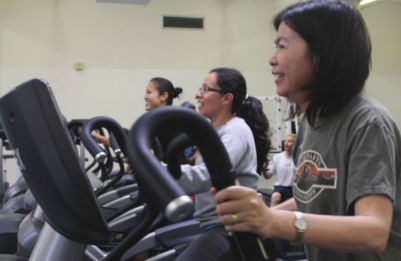Getting in shape: Healthy eating vs. fad diets

With less than a month until Spring Break and summer treading not far behind, many people are setting their aims toward slimming down and getting in shape for bikini season.
As with most things in life, different people use different methods to get in shape and methodology tends to vary from person to person.
Due to the incessant demand for instant gratification, many people shift from doing it healthily with a proper diet and exercise to where others rely on the effects of short lived fad diets.
“Wanting to be in shape isn’t a bad thing. The issue comes when people begin to prioritize being thin over actually being healthy,” Melissa Jones, 26, English major, said.
Picking up momentum, fad diets have been prevalent in American society for years. Some examples of popularized fad diets from recent years include the South Beach Diet, the Atkins diet to a diet that’s entire regime allows you to ingest nothing more than grapefruit juice for several days. And just like hairstyles, they perpetuate themselves among society. Tales of their successes spread like wild fire, especially in an environment like the one here at EC – one that is social and stress filled, which has the potential for pressure among insecure students.
“It’s an issue that isn’t always in your face, but it’s always there, for girls, at least,” Melissa Worth, 19, mathematics major, said. “I can’t speak for guys. But I can for myself or from what I’ve witnessed and it really drives us insane.”
Fad diets are just that – fads. So with time their popularity wanes. The most prevalent types of fad diets perpetuated among students on campus, are those labeled as health conscious rather than weight conscious – whether it is true or not.
Trends like going raw, a diet that involves eating nothing cooked whatsoever, various juice cleanses restrictive of any food whatsoever and cutting gluten are all very popular.
But are they safe?
Undoubtedly, popularity is not always dictation of whether or not something might be constructive and useful or destructive and harmful. Of poisonous trends perpetuated among society, fad diets are some of the most detrimental to the well being of the participants as they make a promise they don’t intend to keep, while some simultaneously worsen health at the same time.
“A good rule of thumb and determinant of whether or not a fad diet is safe or good for you is deprivation. If a diet is in any way shape or form depriving your body of vital nutrients, vitamins, calories or anything else it needs to run smoothly then it is most likely not the best choice health wise,” Chris Hernandez, 24, a nutrition major and personal trainer, said. “Sure, you may lose some weight but the chances of you keeping it off are slim to none.”
EC offers many services to students to steer clear of fad diets and instead get into shape healthily and safely for a much more long term success rather than the short term fad diets tends to offer. Services include numerous physical education courses, facilities in the Fitness Center and Health Office, as well as courses on nutrition and health.
“It’s good to prioritize health and strength over pant size and vanity,” Hernandez said. “The best thing for people to do is instead incorporate exercise and eating healthy into their regular daily life, and actually stick with it.”
Hernandez said the minimum requirement for anyone to maintain a healthy shape is consistent movement and aerobic exercise three days a week, thirty minutes each day. He also says those who want to actually lose weight should work up from there in how much time they spend exercising, but should all, at least be doing those three days a week.
“You don’t have to deprive yourself of your favorite foods, but when you make it a habit to already keep yourself healthy then you don’t have to resort to fad diets to begin with every time that season rolls around,” Hernandez said.







